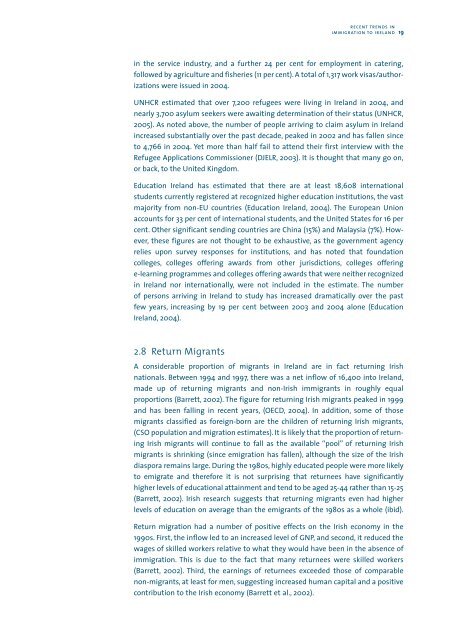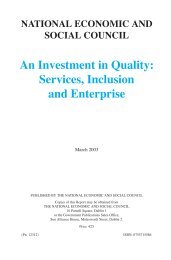Managing Migration in Ireland - European Commission - Europa
Managing Migration in Ireland - European Commission - Europa
Managing Migration in Ireland - European Commission - Europa
Create successful ePaper yourself
Turn your PDF publications into a flip-book with our unique Google optimized e-Paper software.
ecent trends <strong>in</strong>immigration to ireland 19<strong>in</strong> the service <strong>in</strong>dustry, and a further 24 per cent for employment <strong>in</strong> cater<strong>in</strong>g,followed by agriculture and fisheries (11 per cent). A total of 1,317 work visas/authorizationswere issued <strong>in</strong> 2004.UNHCR estimated that over 7,200 refugees were liv<strong>in</strong>g <strong>in</strong> <strong>Ireland</strong> <strong>in</strong> 2004, andnearly 3,700 asylum seekers were await<strong>in</strong>g determ<strong>in</strong>ation of their status (UNHCR,2005). As noted above, the number of people arriv<strong>in</strong>g to claim asylum <strong>in</strong> <strong>Ireland</strong><strong>in</strong>creased substantially over the past decade, peaked <strong>in</strong> 2002 and has fallen s<strong>in</strong>ceto 4,766 <strong>in</strong> 2004. Yet more than half fail to attend their first <strong>in</strong>terview with theRefugee Applications <strong>Commission</strong>er (DJELR, 2003). It is thought that many go on,or back, to the United K<strong>in</strong>gdom.Education <strong>Ireland</strong> has estimated that there are at least 18,608 <strong>in</strong>ternationalstudents currently registered at recognized higher education <strong>in</strong>stitutions, the vastmajority from non-EU countries (Education <strong>Ireland</strong>, 2004). The <strong>European</strong> Unionaccounts for 33 per cent of <strong>in</strong>ternational students, and the United States for 16 percent. Other significant send<strong>in</strong>g countries are Ch<strong>in</strong>a (15%) and Malaysia (7%). However,these figures are not thought to be exhaustive, as the government agencyrelies upon survey responses for <strong>in</strong>stitutions, and has noted that foundationcolleges, colleges offer<strong>in</strong>g awards from other jurisdictions, colleges offer<strong>in</strong>ge-learn<strong>in</strong>g programmes and colleges offer<strong>in</strong>g awards that were neither recognized<strong>in</strong> <strong>Ireland</strong> nor <strong>in</strong>ternationally, were not <strong>in</strong>cluded <strong>in</strong> the estimate. The numberof persons arriv<strong>in</strong>g <strong>in</strong> <strong>Ireland</strong> to study has <strong>in</strong>creased dramatically over the pastfew years, <strong>in</strong>creas<strong>in</strong>g by 19 per cent between 2003 and 2004 alone (Education<strong>Ireland</strong>, 2004).2.8 Return MigrantsA considerable proportion of migrants <strong>in</strong> <strong>Ireland</strong> are <strong>in</strong> fact return<strong>in</strong>g Irishnationals. Between 1994 and 1997, there was a net <strong>in</strong>flow of 16,400 <strong>in</strong>to <strong>Ireland</strong>,made up of return<strong>in</strong>g migrants and non-Irish immigrants <strong>in</strong> roughly equalproportions (Barrett, 2002). The figure for return<strong>in</strong>g Irish migrants peaked <strong>in</strong> 1999and has been fall<strong>in</strong>g <strong>in</strong> recent years, (OECD, 2004). In addition, some of thosemigrants classified as foreign-born are the children of return<strong>in</strong>g Irish migrants,(CSO population and migration estimates). It is likely that the proportion of return<strong>in</strong>gIrish migrants will cont<strong>in</strong>ue to fall as the available “pool” of return<strong>in</strong>g Irishmigrants is shr<strong>in</strong>k<strong>in</strong>g (s<strong>in</strong>ce emigration has fallen), although the size of the Irishdiaspora rema<strong>in</strong>s large. Dur<strong>in</strong>g the 1980s, highly educated people were more likelyto emigrate and therefore it is not surpris<strong>in</strong>g that returnees have significantlyhigher levels of educational atta<strong>in</strong>ment and tend to be aged 25-44 rather than 15-25(Barrett, 2002). Irish research suggests that return<strong>in</strong>g migrants even had higherlevels of education on average than the emigrants of the 1980s as a whole (ibid).Return migration had a number of positive effects on the Irish economy <strong>in</strong> the1990s. First, the <strong>in</strong>flow led to an <strong>in</strong>creased level of GNP, and second, it reduced thewages of skilled workers relative to what they would have been <strong>in</strong> the absence ofimmigration. This is due to the fact that many returnees were skilled workers(Barrett, 2002). Third, the earn<strong>in</strong>gs of returnees exceeded those of comparablenon-migrants, at least for men, suggest<strong>in</strong>g <strong>in</strong>creased human capital and a positivecontribution to the Irish economy (Barrett et al., 2002).
















